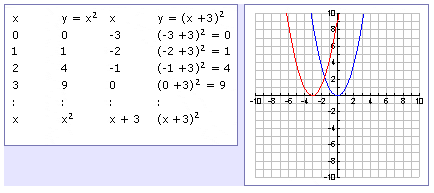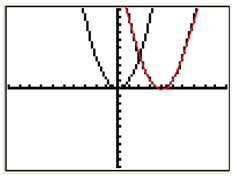Transformations
| Site: | Clare |
| Course: | Michigan Algebra I Sept. 2012 |
| Book: | Transformations |
| Printed by: | Guest user |
| Date: | Wednesday, December 17, 2025, 7:24 AM |
Description
Transformations
Transformation
To translate the graph of a quadratic function, you can use the vertex form, y = a(x - h) 2 + k.
- The h-value will translate the graph to the right when it is negative and to the left when it is positive.
- The k-value will translate the graph up when it is positive and down when it is negative.
Example The equation, ![]() , represents what translation of the parent function,
, represents what translation of the parent function, ![]() ?
?
Since the h -value is negative, the translation will be 3 units to the right. Since the k -value is positive, the translation will be up 4 units.
Up or Down

By looking at both the table of values and the graph, k produces a vertical shift; in this case, k = 3 shifts the parabola up 3 units.
In function notation, to move a function up, add outside the function. The function f(x) + c is f(x) moved up c units. Moving the function down works the same way, the function f(x) - c is f(x) moved down c units.
Left or Right

By looking at both the table of values and the graph, it appears as though h produces a horizontal shift; in this case, h = -3 shifts the parabola 3 units to the left. Expressing the equation in vertex form, y = (x + 3)2 = (x - (-3))2. In general, the graph is shifted h units to the right if h is positive, and h units to the left if h is negative.
In function notation, to shift a function left, add inside the function's argument: f(x + b) shifts f(x) b units to the left. Shifting to the right works the same way, f(x - b) shifts f(x) b units to the right.
Effects of "a"
Example The graph below represents the function

Reflecting Over the x-axis

In function notation, this reflection is represented by a negative outside the function: -f(x). If the negative is inside the function notation, there is a reflection across the y -axis. Since a parabola is already symmetric about the y -axis, this transformation does not actually change the look of the parabola.
Summary of the Rules
- f(x) + c is f(x) translated upward c units
- f(x) - c is f(x) translated downward c units
- f(x + b) is f(x) translated left b units
- f(x - b) is f(x) translated right b units
- -f(x) is f(x) reflected about the x-axis
- f(-x) is f(x) reflected about the y-axis
- a•f(x) stretches the graph vertically if a > 1
- a•f(x) shrinks the graph vertically if 0 < a < 1
Equations
Example 1 The graph of y = x2 is transformed to produce the new red graph. What's the new equation?

Step 1. Determine the transformation of the graph.
This graph has been translated 4 units right.
Step 2. Use the transformation rules to write an equation.
f(x - b) translates the graph to the right.
The equation will be:
y = (x - 4) 2
Interactive Activity
Transformations of Parabolas
Interactive Practice
Guided Practice
Guided Practice
Practice
Answer Key
Sources
Embracing Mathematics, Assessment & Technology in High Schools; A Michigan Mathematics & Science Partnership Grant Project
HotMath, http://hotmath.com/util/hm_flash_movie_full.html?movie=/ learning_activities/interactivities/translating_scaling.swf (accessed 07/24/2010).
Holt, Rinehart & Winston, "Quadratic Functions." http://my.hrw.com/math06_07/nsmedia/homework_help/alg2/alg2_ch05_01_homeworkhelp.html (accessed 8/22/2010).
MAC 1105 College Algebra, http://itech.pjc.edu/falzone/course/ 1105handouts.htm (accessed 08/05/2010).
Purple Math, "Function Transformations/Translations." http://www. purplemath.com/modules/fcntrans.htm (accessed 07/24/2010).